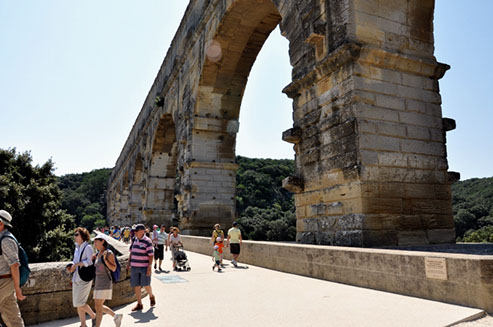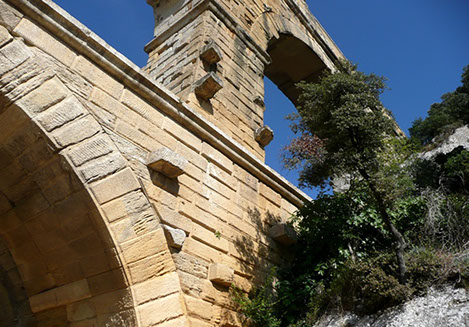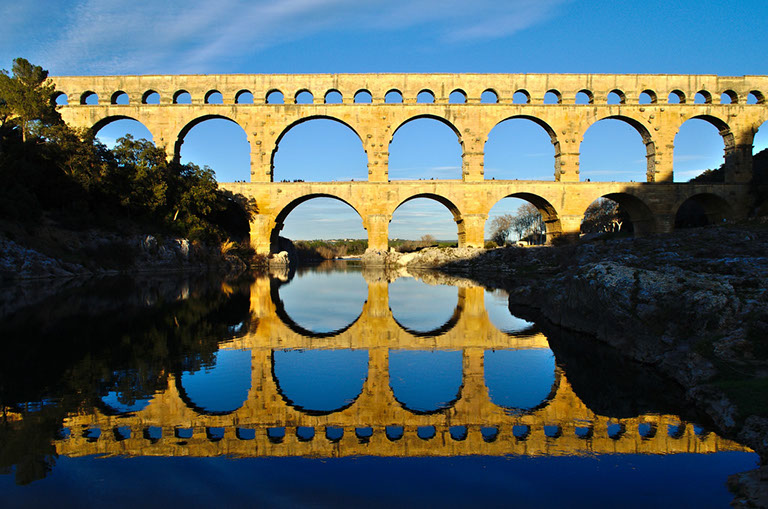
The Gard bridge is an aqueduct in the south of France built by the Roman Empire. The bridge was built during the 1st century A.D. and was part of the Nîmes aqueduct, a 50 kilometre-long gravity-fed water pipeline that carried water from a spring in Uzès to the Roman colony of Nemaususus (Nimes).
It is located next to the village of Remoulins, in the department of Gard.
Pont du Gard in French (original language). The river Gard, to which the department in which it is located owes its name, does not really exist under this name. The river is formed by many tributaries, many of which are called Gardon and are also called Gardon.
EThe bridge was built by Marco Vipsanio Agrippa. Neglected over time, the aqueduct lost its usefulness around the 9th century, when sediments completely obstructed the passage of water. Until the 18th century, it was used as a bridge to cross the river on foot, but the construction of a new bridge in 1702 allowed the best conservation of the Pont du Gard to this day.
The aqueduct was built by the Romans in the first century and added to the UNESCO World Heritage List in 1985. It is the highest of the Roman aqueduct bridges and is the best preserved after the one in Segovia.
The Romans built numerous aqueducts (latínaquaeductūs, sing. aquaeductus) to provide water to the cities and industrial sites in their empire. These aqueducts were among the greatest engineering achievements of the ancient world and set an unmatched standard for more than a thousand years after the fall of Rome. Today many cities maintain and use the old aqueducts although the open canals have normally been replaced by pipes.
The city of Rome itself, being the largest city, had the largest concentration of aqueducts, with water provided by eleven aqueducts built over a period of five hundred years. Scholars have come to predict the size of the city by its water supply.
They provided drinking water, numerous toilets and fountains in the city and finally emptied themselves into sawmills, where they performed their last function, that of removing waste. The methods for construction were well described by Vitruvius in his work De Architectura, written in the first century BC. His book was of great help to Frontino, a general who was appointed, at the end of the first century, to manage the many aqueducts of Rome. He discovered a clear difference between the water intake and that supplied, which was caused by the illegal pipes inserted in the canals to distract the water; he reported to Emperor Nerva, in his work De aquae ductu Urbis Romae (From the nine aqueducts existing at the time) of the end of the first century, his efforts to improve and regulate the system.
An aqueduct was started in a water catchment system. The water passed, in a controlled way, into the water supply from a headwater tank (caput aquae). The construction of an aqueduct required a thorough study of the terrain that would allow the most economic layout to be chosen to allow a smooth and sustained slope, without extending the route of the work too much. Open channels (riui) were used whenever possible and only rarely were they used under pressure.
The canal was accommodated to the terrain by different procedures. Whenever possible, it was carried out on the ground, supported by a wall (substructio) in which sewers were used to facilitate the normal transit of surface water. If the ground was raised, the channel was buried (riuus subterraneus) and formed an underground gallery (specus) dug directly into the rock or built into a ditch. When a severe depression had to be overcome, complicated arched systems were built to support the canal and keep it at the proper level.
Detail of an arched floor on the second level of the bridge
In any case, whenever the water was intended for human consumption, the canal was covered by vaults, false vaults, stone plates or tiles.
According to Isabel Rodà, Professor of Archaeology at the Autonomous University of Barcelona, 507 kilometres of aqueducts were built, of which 434 kilometres were underground, 15 kilometres in area and only 59 kilometres, that is to say 12%, ran through archways.





BRIDGE OF GARD
ORIGINS










